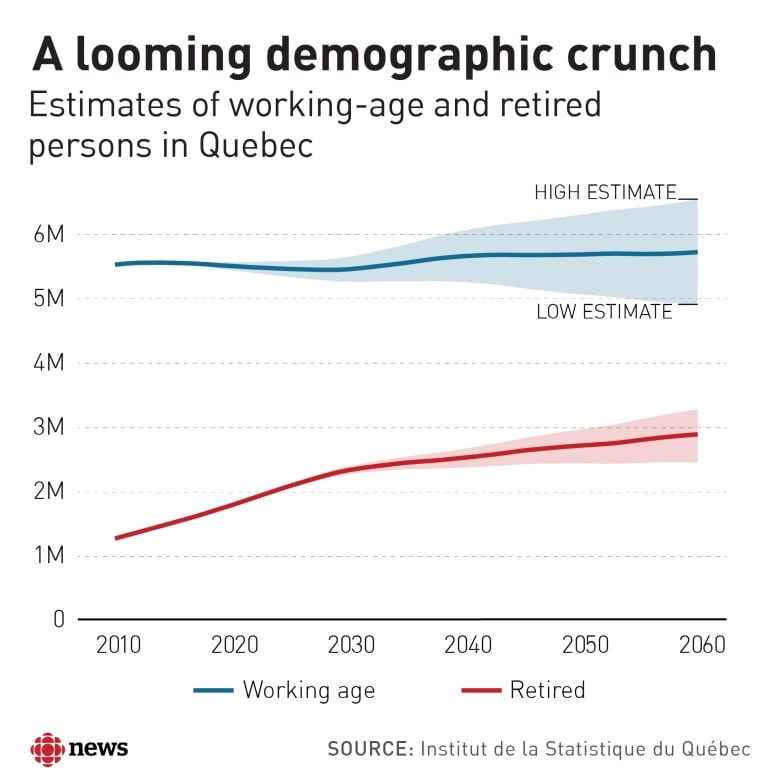Explore Quebec's demographic crunch in 4 charts
Province faces challenge of aging population as CAQ cuts immigration levels

Simply put, Quebec is old — and getting older.
The number of people aged 15 to 64 continues to decline, and the number of older people is on the rise.
The province's annual demographic survey, released earlier this month, shows Quebec has the oldest inhabitants in Canada and that its population is growing slowly.
Studies have shown that an aging population makes it difficult to maintain living standards, dampens growth of government revenue and presents major challenges to public pensions and health-care systems.
It also means the province's labour shortage, which economists expect could slow growth in the coming year, is likely to get worse.
The new Coalition Avenir Québec government, however, is cutting the number of immigrants Quebec takes in each year by 20 per cent — despite concerns about the damage this could do to the province's demographic makeup.
Here are four charts that illustrate the extent of Quebec's demographic crunch, and how we got here.
Quebecers are making fewer babies
Quebec's fertility rate, measured as the average number of children born per woman, has historically been among the lowest in the country.
It's a bit higher than past years, but it's still far below the replacement rate of 2.1. This is the rate at which a population exactly replaces itself from one generation to the next, without migration.

The population is getting greyer
Below is Quebec's population pyramid, a way of visualizing the distribution of ages in a population.
A stable population pyramid actually looks like a pyramid, with more young people compared to older ones.
That's what it looked like in the '70s. But in a few decades, Quebec's will look more like a skyscraper, with a more even distribution of age groups.

Workers won't keep up with retirees
The result of this imbalance is that the number of retirement-age Quebecers (those 65 years or older) will increase, while those of working age will remain steady, according to the government's estimates.

Immigration is driving growth
Population growth is made of two main components: natural growth (births minus deaths) and net migration (people coming in minus people leaving).
Natural growth has been steadily decreasing as fewer women have children. Net migration has been positive for the last 20 years, thanks mostly to international immigrants.
Quebec still loses more people to other provinces than it receives.
In 2017, Quebec saw one of the highest population increases for a single year, but this was mostly due to non-permanent residents.
These are temporary workers, foreign students and asylum seekers, many of whom don't stay.

'One solution can't solve everything'
The CAQ says its cuts to immigration are part of an attempt to correct this problem.
Immigration Minister Simon Jolin-Barrette said recently that the government wants to make sure those who are coming will be better integrated into the workforce.
"What we want is to use our resources so that every person that chooses Quebec has a chance at success," he said.
The decision to cut immigration goes contrary to the consensus among demographic experts.
A new report by the C.D. Howe Institute recommended increasing immigration levels across Canada. And even that won't be enough.
It recommended that heightened immigration be supplemented with increased participation in the labour market, including by those beyond retirement age, will be needed to counter the aging population and address the shortage of workers.
"One solution can't solve anything," said Parisa Mahboubi, a senior policy analyst at the C.D. Howe Institute, who authored a recent study on how to counter the Canada-wide trend.
"Immigration is one channel, increasing work participation is another and they are complementary," she said.

